a German cookbook
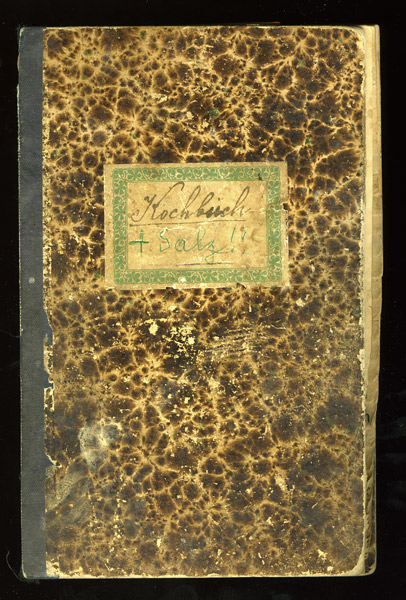
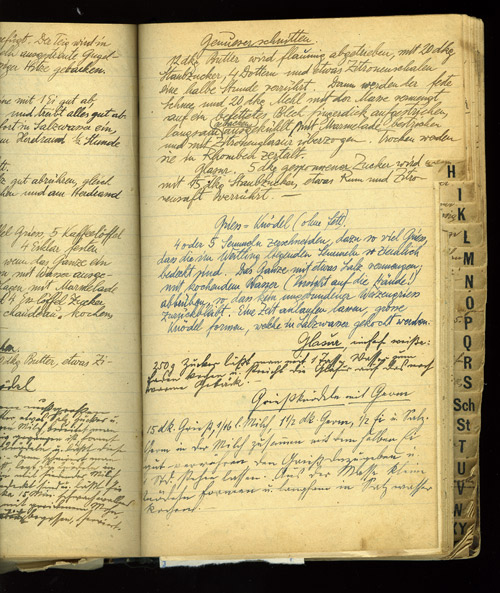
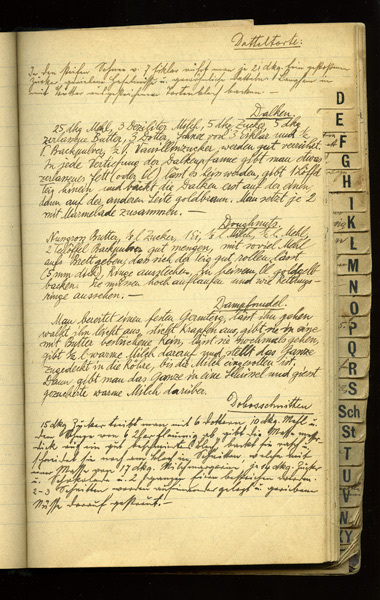
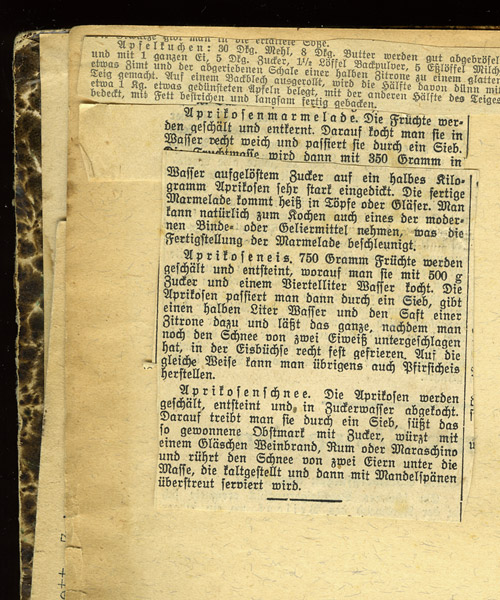
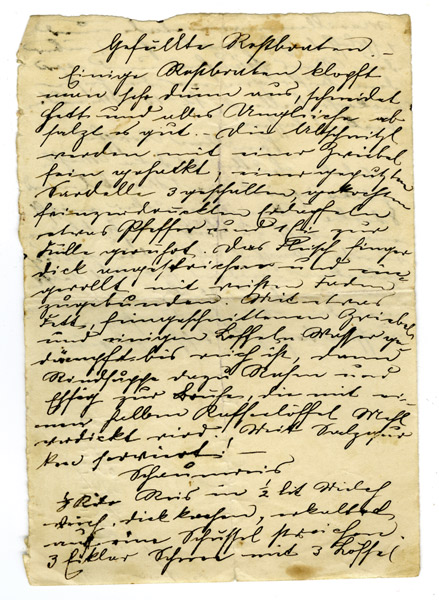
I have been peeking into some of my late mother-in-law’s boxes which my husband brought home from her house, now sold. Her obviously very old handwritten cookbook intrigued me, reminding me a little of my mother’s Finnish cookbook.
While my mother’s book was a published one, “Omi’s” is all handwritten by many different hands in an originally blank and indexed book. I imagine that her mother, grandmothers, aunts, sisters and friends may have written many of these, perhaps for her when she was a new bride, or when she was emigrating to Canada. The handwriting is exquisite and often seeming too tiny to read.
I don’t recognize her handwriting in the book itself unless it changed later, though some of the loose slips may be by her hand. Like in my mother’s cookbook there are numerous slips of loose recipes and clippings inserted throughout, and some glued in, like the one above with Gothic text. My German is poor, and the handwriting hard to read (even husband has trouble) but I do recognize a lot of kuchen (cake) recipes! Omi loved to bake cakes so I’m not surprised.
May 15, 2013 in Books, Found Objects, History, Home, Photoworks by Marja-Leena
It’s a treasure for the handwriting alone even if you can’t decipher much of it. At least the pages I see don’t have food stains. My cookbooks always have a few of those.
Susan, yes, it’s the beautiful handwriting that drew me to the book and made me want to save it and share it here. Not many stains in there.
What surprised me about the recipes is that the ingredient list is not separate as we usually see but instead is part of the whole method description, such as ‘take three eggs and beat well, adding one cup sugar to it a little at a time…’ I’m making that up but you do know what I mean?
It’s beautiful and all the more so for being hand-written and for having several contributors. I would cherish such a family heirloom 🙂
And I think I should start one of my own, so many of the memories of my own childhood involve food, it would be nice to create something similar for my Ragazzi. Handwritten, of course
Marja-Leena: Fascinating! I feel as if one should wear white gloves and open the book in a place of reverence. The book seems to contain so much more than just the writing and printing.
Hello every one, here every person is sharing these knowledge,
thus it’s nice to read this blog, and I used to pay a visit this weblog all the time.
Julia, it really is quite the family heirloom for being all handwritten. I used to think of doing one for each of our daughters, even for myself, but still have not, though they have acquired many favourite family recipes on slips of paper or recipe cards or via email. I hope you will do it for yours – and show it to us!
Tom, yes, that is the feeling – the white gloves as if handling a treasured museum piece! The hidden secrets of who wrote all these recipes, what might their stories be, why was it forgotten all these years and not shown to her children? So many questions…
Taren, I’m pleased you are enjoying visiting once again.
Fascinating! The handwriting is beautiful and readable. It strikes me that the notes are there to jog the memory. One would have to have the measuring implements, too, I am guessing. I recently asked my Mama’s oldest friend for a recipe and she told it to me over the phone in the style of a narrative.
Marja-Leena,
I worked on my graduation thesis (on drama, handling amateur theatre) in the early 90’s and I was sitting a lot in archives reading about this or that nuorisoseura (youth club) – or työväenyhdistys (workers organization) and especially their acting – for someone outside Finland I got to add that Finnish theatre was born from hundreds of amateur theaters all over the country.
I had to read a lot of handwritten plays, handwritten programs, minutes of meetings, and I say I can read handwriting as well as any apothecary. But in those times good, readable and beautiful handwriting was a greatly evaluated skill. My research included time from 1890’s to 1939.
I did study German is school and I can understand some of those recipes. Beautiful! A real treasure! Not that cakes are awfully healthy for anybody, but if it is baked by a grandmother, there isn’t anything better in the world!
Rouchswalwe, you must be very familiar with the German handwriting and many of the recipes. Do you suppose many of them may be variations on basic sponge and butter cakes so blending methods are assumed?
Marjatta, your thesis sounds fascinating! I hope you don’t mind I added translations in brackets to the two Finnish terms. Reading varieties of handwriting is a skill that surely improves with practice.
Styles vary with time and place, don’t you think? My mother’s handwriting was like that of so many others of her time. The German script seems to me very different from the Finnish. I see many variations in the cookbook which perhaps reveal styles of different generations, and many are not too hard to read. Mother-in-law’s was such that the letters flow together, beautifully, but with hardly a bump to tell you what each letter is. We’ve seen the same in husband’s cousins’ writing which he struggles to read. Your skills, as good ‘as any apothecary’ (heh!) would be useful! We sure don’t have that beautiful penmanship anymore.
Oh, my mother baked ‘pulla’ and cake every week and I used to bake a lot when my family was young, now only for very special occasions. Times have changed.
How lovely, and how suitable to your love for artifacts and the changes of time. We have the recipes of my husband’s grandmother, though they were just in a jumble. I put them in a book for him, as he is our main cook and learned from his grandmother.
An awful lot of doughnut recipes! f we got as much exercise as they did, more cake would be fine…
I had the worst handwriting in the class in 3rd grade and became the special project of our weekly handwriting teacher. And had a perfect Palmer hand at the end of the year. Now it’s much more idiosyncratic with its own eccentric flourishes, but people often comment on it–so much so that it really makes me think about how we’ve lost cursive. My boys print for the most part, and my daughter’s cursive is not particularly pretty, even though she is very involved in art. A lost pursuit. Perhaps it will come back in some small way, as we begin to miss what we have thrown on the rubbish heap of history.
Marly, you noticed again how another object I feature fits in with my love for artifacts, thanks. Funny, I love them as images yet struggle with even more ‘stuff’ coming into our home 🙂 Yes, I did notice a few doughnut recipes but they seemed to be mostly cakes.
You had a handwriting teacher! I recall just doing it in regular classes in school with these horrible nib pens and bottles of ink sitting in a hole in the desk. I even have a tattoo where a worn pen nib slipped and punctured a finger accidentally. Yes, cursive writing seems out but amazingly there are many such digital fonts available. The iPad even has an app for handwriting directly on the tablet.
Marja-Leena, I imagine that yes, many must be variations on the “Boden” … something that was baked most Saturdays for the next day. My Mama would only note down variations she rarely baked to jog her memory when the special occasion arrived.
Oh how I would love to taste one of those variations again!
One hand written recipe it seems to me is worth 10 printed ones even if you don’t read the language in which it is written.
Rouchswalwe, isn’t it fascinating how foods, especially baking, are so much a part of our fondest memories of our mothers (and grandmothers if you were lucky to know them)?
Joe, yes, the handwritten is so personal and even historic as we found it in a box of very old photos and diaries – like family archives.
Fun to see that old German print that I learned in high school German class. I like some of those recipes, but how would you peel an apricot? It would have to be very hard and unripe.
We did find, living in Germany and Switzerland, that it never got warm enough for apricots to ripen completely, so they always had sugar added and were fixed in some elaborate way.
Hattie, you took German in high school?! That was useful later when living in Switzerland and Germany. I can read a little but not the much of the handwriting. I used to be able to read the Gothic text in my youth because the Finnish hymn books were in that print. Forgotten now.
Would you not remove the peel by first plunging the fruit in hot water for a short while, like one does with other soft skinned fruits? I haven’t tried it myself. BC apricots bought in stores are often tastier when cooked in a little sugar because they are picked a little under ripe. I love the sweet ones ripe right off trees grown in the interior where summers are hot and dry.